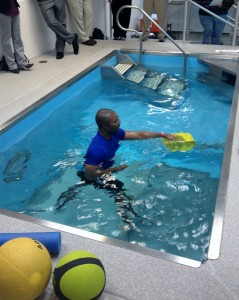Aquatic Conditioning for Your Core
What Is Sports Performance Training?
According to the Sports Medicine Training Center, “the goal of sports performance training is to enhance your performance in competition to make you more successful in your chosen sport. It differs from personal training in which the primary goal is usually to improve overall fitness.” Therefore sports performance training and conditioning includes a wide variety of training regiments and activities.
Where Should You Start With Performance Training?
One of the best places to start or focus on when beginning your performance training is the core. As an athlete, all of your movements stem from your center, the core. Without a strong ‘base’ injury becomes more likely, which as an athlete is the last thing that you want to endure.
Benefits Of Core Training
Murphy Grant, head athletic trainer and Director of Sports Medicine for the University of Kansas, performed an aquatic demonstration in the HydroWorx pool at the Nationals Park, home of the MLB Washington Nationals, where he demonstrated and discussed a number of important core strengthening exercises for training.
Grant reiterates that the core is where the body’s center of gravity is located and where all movement begins, which is why establishing core stabilization programs for your athletes or even yourself is extremely important. Core training is extremely beneficial for proper posture and balance. Strengthening your stabilizers and your balance can potentially save you from injury down the road. Your body will have been trained to regain balance and stabilize when you are about to fall, get pushed around or when you take a wrong step. The pool is an ideal environment for core and performance training because the water creates natural resistance for added strengthening that you cannot create on land. Additionally, in the pool the risk of injury is eliminated due to water’s unweighting ability.
Best Aquatic Core Exercises
Core Pulls
The individual works on pulling their abdominal tight and in toward their spine, however the athlete must be able to communicate and talk even though their muscles are contracted.
Isomatic Core Crunches
Using a small to medium Swiss ball in the water, the individual wraps their arms around and pushes it underwater to create a small but effective abdominal crunch.
Safety Bar Lower Abdominal Crunch
The athlete performs a crunch while holding themselves up in between the two treadmill bars.
Swiss Ball Sit
Simply sit on the Swiss ball in the water, which activates your core to stabilize in order to stay seated on the ball.
Wood Chops with HydroTones
Woodchoppers can be performed first without the HydroTone for a warm up and then with the HydroTones to create added resistance (demonstrated in the video). These can be done laterally (side to side) as well as diagonally.
Stabilize the body and then slowly bring the hydrotones across to the other side of the body while keeping the body at a good base. As the intensity builds, the movement from the water will get agitated and create more resistance.
Box Pattern
This exercise is simply making a box in the water with a HydroTone, which Grant describes will incorporate every part of your core.
Core Setting
The goal of core setting is for the patient or athlete to tighten their abs, keep their back against the wall and experience the tightness that builds around the abdominal pressure. This will increase the ability of the patient or athlete to do simple exercises such as reaching over their head or sitting in a chair.
T-Push Ups
This exercise benefits a variety of different ranges of motion in different angles and positions. Go slow and use full range of motion while pushing the force of water with this movement.


